Question
Fig. 4.1 shows a section through an insect-pollinated flower.
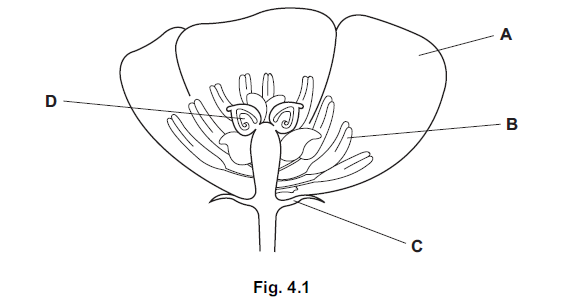
(a) Name the parts labelled A, B, C and D as shown on Fig. 4.1.

(b) (i) Define the term pollination.

(ii) Pollination can be carried out by insects or by wind.
Describe four features of flowers that would show they are insect-pollinated.
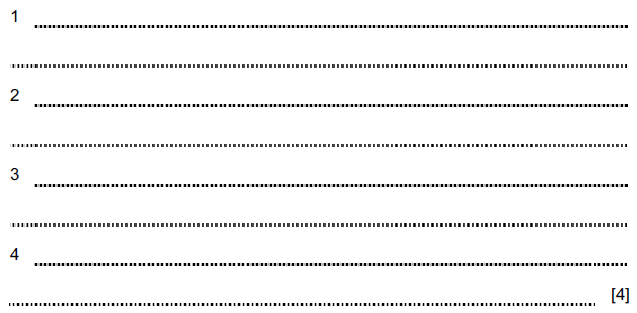
(c) Wind-pollinated flowers produce much more pollen than insect-pollinated flowers.
This pollen is usually lighter than pollen from insect-pollinated flowers.
Suggest why these are advantages to a plant that is wind-pollinated.

Answer/Explanation
Ans:
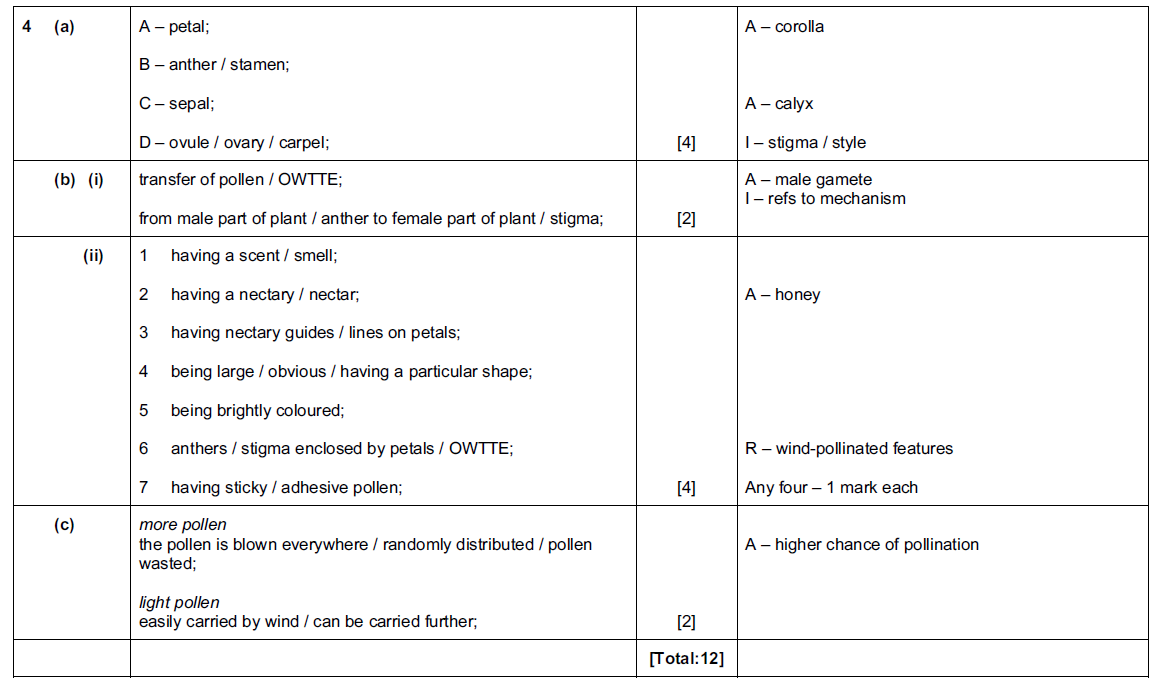
Question
Fig. 5.1 is an image of a germinating seed showing the growing root.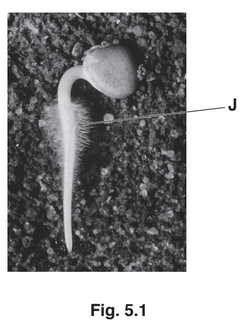
(a) Describe and explain how the structures seen at J are adapted for their function.
…………………………………………………………………………………………………………………………………
…………………………………………………………………………………………………………………………………
…………………………………………………………………………………………………………………………………
…………………………………………………………………………………………………………………………………
…………………………………………………………………………………………………………………………………
…………………………………………………………………………………………………………………………………
…………………………………………………………………………………………………………………………………
…………………………………………………………………………………………………………………………………
…………………………………………………………………………………………………………………………………
…………………………………………………………………………………………………………………………………
……………………………………………………………………………………………………………………………..[5]
15
© UCLES 2016 0610/41/O/N/16 [Turn over
(b) (i) The root shown in Fig. 5.1 is growing downward into the soil.
Name this response seen in roots.
………………………………………………………………………………………………………………………[1]
(ii) Name the chemical that controls this response.
………………………………………………………………………………………………………………………[1]
(iii) There are situations, either in wild plants or in laboratory experiments, where roots do
not grow downwards.
Suggest and explain one situation.
………………………………………………………………………………………………………………………….
………………………………………………………………………………………………………………………….
………………………………………………………………………………………………………………………….
………………………………………………………………………………………………………………………….
Answer/Explanation
Ans:
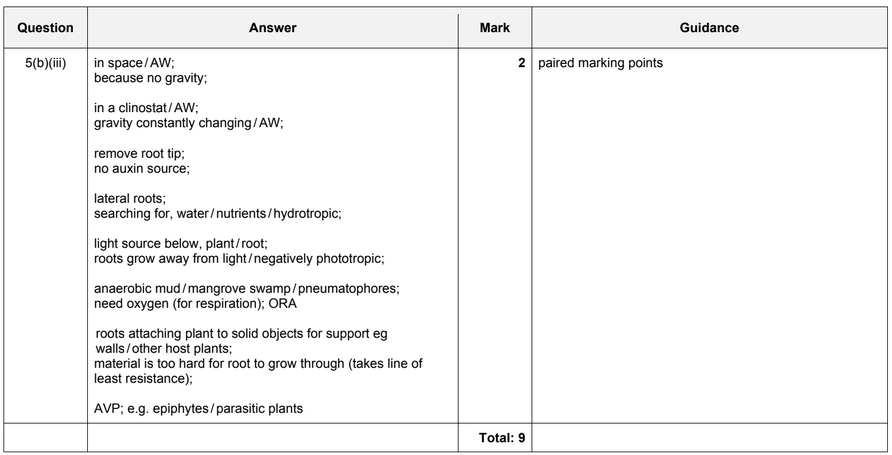
Question
The flowers of pea plants can be pollinated by bees.
(a) State three features of flowers that would attract insects such as bees.
1 ………………………………………………………………………………………………………………………………
…………………………………………………………………………………………………………………………………
2 ………………………………………………………………………………………………………………………………
…………………………………………………………………………………………………………………………………
3 ………………………………………………………………………………………………………………………………
…………………………………………………………………………………………………………………………………
Answer/Explanation
Ans:
scent ;
nectar ;
‘honey’ guides ;
colourful petals ;
large petals ;
pollen (as source of food) ;
Question
(b) Successful pollination results in fertilisation.
Describe the events that occur after pollen grains leave the anther of a flower until fertilisation
takes place.
…………………………………………………………………………………………………………………………………
…………………………………………………………………………………………………………………………………
…………………………………………………………………………………………………………………………………
…………………………………………………………………………………………………………………………………
…………………………………………………………………………………………………………………………………
…………………………………………………………………………………………………………………………………
…………………………………………………………………………………………………………………………………
…………………………………………………………………………………………………………………………………
…………………………………………………………………………………………………………………………………
Answer/Explanation
Ans:
pollen lands on stigma ;
pollen tube grows ;
through style ;
to ovary ;
(pollen nucleus
/ male gamete) enters ovule ;
through micropyle ;
pollen and ovule / egg, nuclei fuse ;
Question
(c) Following fertilisation, seeds will form.
In pea plants there are two alleles for height:
• tall (T)
• dwarf (t)
(i) Define the term allele.
………………………………………………………………………………………………………………………….
………………………………………………………………………………………………………………………….
…………………………………………………………………………………………………………………………
Answer/Explanation
Ans:
a version / type, of a gene ;
Question
(ii) A farmer wanted to identify the genotype of tall pea plants as either homozygous
dominant or heterozygous.
He used a homozygous recessive dwarf pea plant to determine the genotype of the tall
pea plants.
State the name of this type of genetic cross.
………………………………………………………………………………………………………………………….
Answer/Explanation
Ans:
test cross ;
Question
(iii) Complete the genetic diagram to determine the genotype of the parent plant if all the offspring from the cross are tall plants.
parental phenotypes tall × dwarf
parental genotypes ……………………………. × …………………………….
gametes 
offspring genotype ……………………………………………………………………………………………….
offspring phenotype ……………………………………………………………………………………………..
Answer/Explanation
Ans:
parental phenotypes tall x dwarf
parental genotypes TT ; x tt ;
gametes
T T x t t ;
offspring genotype Tt ;
offspring phenotype (100%) tall
Question
(iv) Another farmer wants to produce pure-breeding dwarf pea plants.
State the genotypes of both of the parent pea plants the farmer should use.
Give a reason for your choice.
genotypes …………………………………………………………………………………………………………..
reason ……………………………………………………………………………………………………………….
………………………………………………………………………………………………………………………….
Answer/Explanation
Ans:
tt ;
so that no dominant allele is present / all alleles are recessive / AW ;
recessive alleles only expressed if no dominant allele present ;
Question
Question
(a) Fig. 2.1 shows some flowers of a snapdragon plant, Antirrhinum majus.
Snapdragons are insect-pollinated plants.
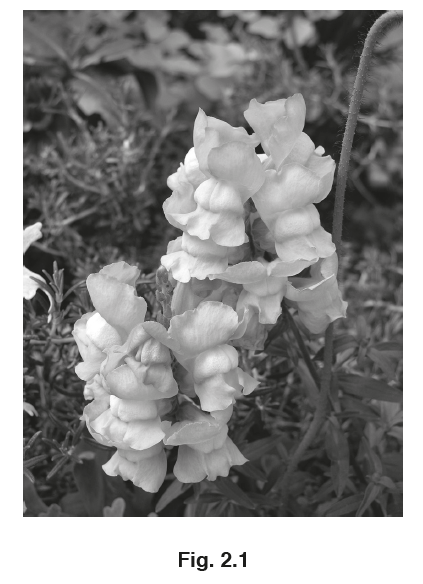
(i) State one feature visible in Fig. 2.1 that suggests these flowers are insect-pollinated.
……………………………………………………………………………………………………………………. [1]
(ii) State how self-pollination differs from cross-pollination.
………………………………………………………………………………………………………………………….
………………………………………………………………………………………………………………………….
……………………………………………………………………………………………………………………. [1]
(iii) Suggest why self-pollination might be advantageous to a population of plants.
………………………………………………………………………………………………………………………….
………………………………………………………………………………………………………………………….
………………………………………………………………………………………………………………………….
………………………………………………………………………………………………………………………….
………………………………………………………………………………………………………………………….
………………………………………………………………………………………………………………………….
……………………………………………………………………………………………………………………. [3]
(b) Petal colour in the flowers of snapdragon plants shows co-dominance.
The gene for petal colour has two co-dominant alleles:
• CR for red petals
• CW for white petals
Table 2.1 shows the genotypes and phenotypes of snapdragon plants with different petal
colours.
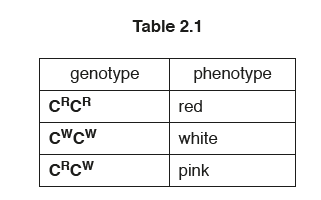
(i) Explain the term co-dominance.
………………………………………………………………………………………………………………………….
………………………………………………………………………………………………………………………….
………………………………………………………………………………………………………………………….
………………………………………………………………………………………………………………………….
……………………………………………………………………………………………………………………. [2]
(ii) A botanist crossed two snapdragon plants with pink flowers.
Complete the genetic diagram to show the ratio of expected phenotypes in the offspring.
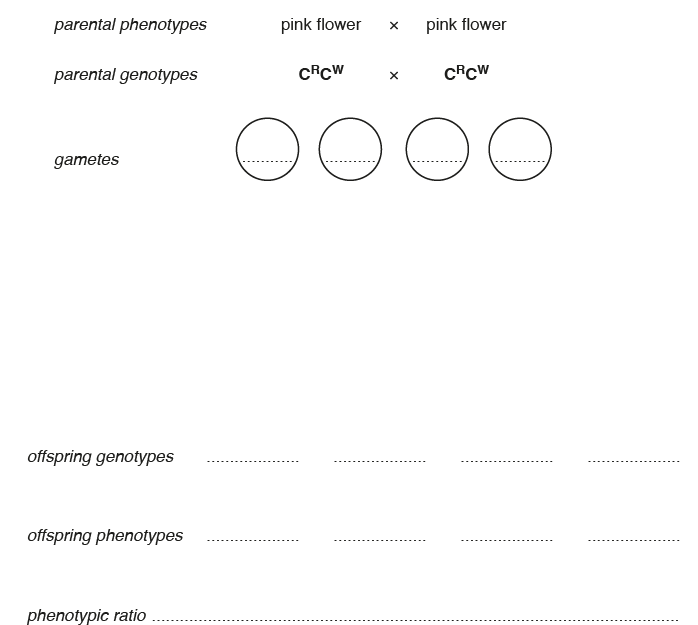
[4]
(iii) The botanist wanted to produce a generation of snapdragons that all had pink flowers.
State the phenotypes of the parent plants that the botanist would need to cross.
Explain your answer.
parent phenotypes ………………………………………………………………………………………………
explanation …………………………………………………………………………………………………………
………………………………………………………………………………………………………………………….
………………………………………………………………………………………………………………………….
[2]
Answer/Explanation
Ans:
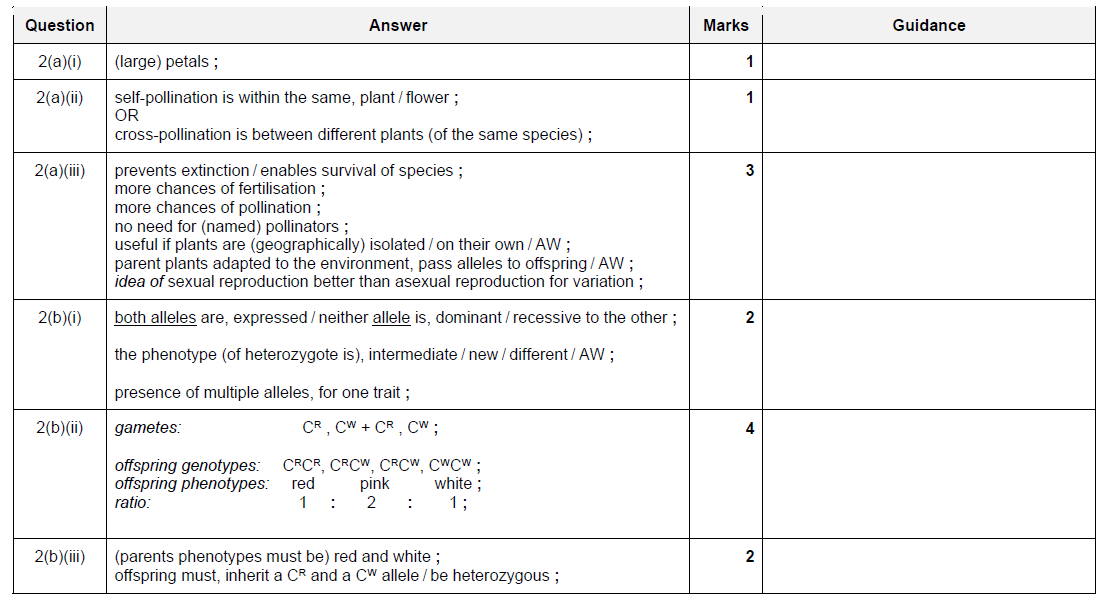
Question
Johnson grass, Sorghum halepense, is wind-pollinated.
(a) Fig. 4.1 shows some Johnson grass flowers.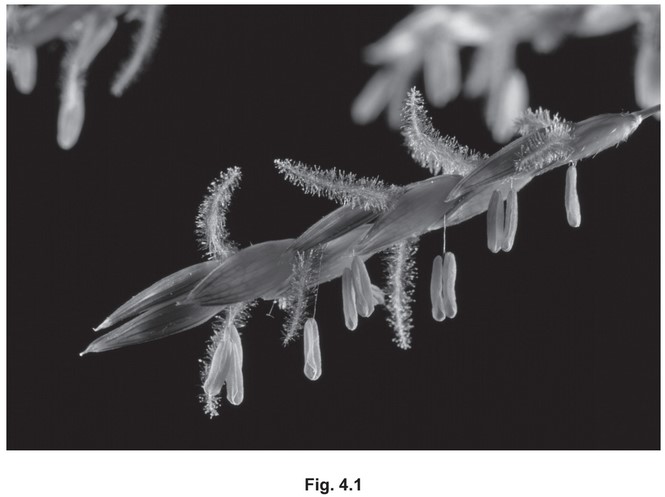
(i) State the genus of Johnson grass.
(ii) Describe two features visible in Fig. 4.1 that show that Johnson grass flowers are
adapted for wind-pollination.
1 ……………………………………………………………………………………………………………………….
………………………………………………………………………………………………………………………….
2 ……………………………………………………………………………………………………………………….
………………………………………………………………………………………………………………………….
(b) Fig. 4.2 shows a section through a carpel shortly after pollination.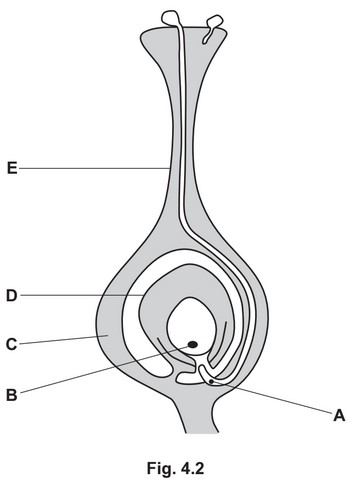
(i) State the names of the parts of the carpel labelled C, D and E.
C ……………………………………………………………………………………………………………………….
D ……………………………………………………………………………………………………………………….
E ……………………………………………………………………………………………………………………….
(ii) Complete the sentences:
Pollen grains are formed in anthers. During their formation the number of chromosomes
in the nuclei is halved by the process of ………………………………………. . This means the
male nucleus A in the pollen tube is described as a ………………………………………. nucleus.
When nucleus A ………………………………………. with nucleus B, the chromosome number
doubles to form a ………………………………………. nucleus. The name of this process is
………………………………………. . Then the ………………………………………. divides by the
process of ………………………………………. to form an embryo.
(c) Discuss the advantages of sexual reproduction to a wild population of flowering plants such
as Johnson grass.
(d) Sexual reproduction requires energy.
State three uses of energy in organisms other than in reproduction.
1 ………………………………………………………………………………………………………………………………
2 ………………………………………………………………………………………………………………………………
3 ………………………………………………………………………………………………………………………………
Answer/Explanation
Answer:
(a) (i) Sorghum ;
(ii) feathery stigma / stigma with large surface area ;
stigma / anthers, hang outside the flower(s) ;
(b) (i) C ovary (wall) ;
D ovule ;
E style ;
(ii) meiosis / reduction division ;
haploid ;
fuses / joins / combines ;
diploid ;
fertilisation ;
zygote ;
mitosis ;
(c) any five from:
(gives) genetic variation / diversity ;
ref to, alleles / genes / DNA, from different, plants / parents ;
allows mutations to be, expressed / AW ;
allows adaptation to, new conditions / changed environment / AW ;
(new species) can evolve / allows natural selection to occur ;
pollen exchanged between individuals / cross pollination ;
seeds are dispersed ;
can colonise new areas / AW ;
less competition (with parent plant / among offspring) ;
seeds may be dormant ;
survival through, harsh / adverse, conditions ;
AVP ;
(d) any three from:
protein synthesis ;
transport in the phloem ;
cell division / mitosis / meiosis ;
active transport / absorption of ions (from the soil) ;
growth ;
movement / muscular contraction ;
sensitivity ;
nerve impulses ;
AVP ;;;
Question
Fig. 4.1 shows a section through an insect-pollinated flower.

(a) Name the parts labelled A, B, C and D as shown on Fig. 4.1.

(b) (i) Define the term pollination.

(ii) Pollination can be carried out by insects or by wind.
Describe four features of flowers that would show they are insect-pollinated.

(c) Wind-pollinated flowers produce much more pollen than insect-pollinated flowers.
This pollen is usually lighter than pollen from insect-pollinated flowers.
Suggest why these are advantages to a plant that is wind-pollinated.

Answer/Explanation
Ans:

Question
Fig. 6.1 shows a section through a seed.
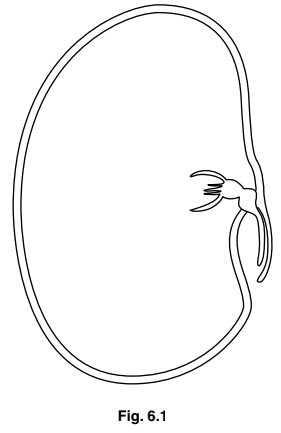
(a) Using label lines, identify the following structures on Fig. 6.1:
the plumule;
the radicle;
the testa.
(b) Name the structure in the seed that contains a store of food.
(c) State the importance of seed dispersal to a plant.
Answer/Explanation
(a) plumule ;
radicle ;
testa ;
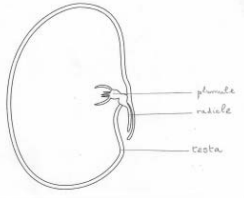
(b) cotyledon ;
(c) colonise new areas / more space (for plant to grow) ;
reduce competition (for resources / named resource) ;
Question
Fig. 4.1 shows a section along a pea pod, the fruit of a pea plant.
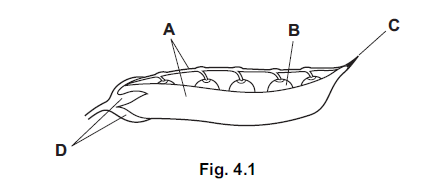
(a) (i) Name the parts of the original pea flower from which structures A and B have
developed.

(ii) Parts C and D are the remains of parts of the pea flower. Suggest which part C
was and which part D was in the original flower.

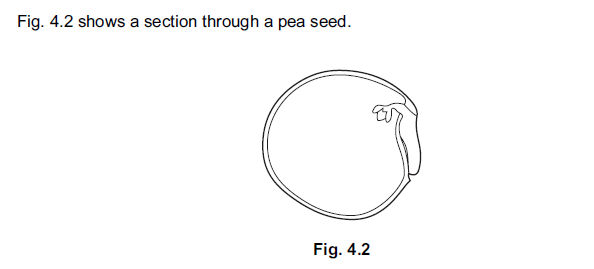
(b) Label, with a label and line on Fig. 4.2 the plumule, the radicle and the testa of this
seed.
Put your labels on Fig. 4.2. [3]
(c) State two ways in which seeds are dispersed.

(d) Name three factors that are essential for all seeds to germinate.

Answer/Explanation
Ans:
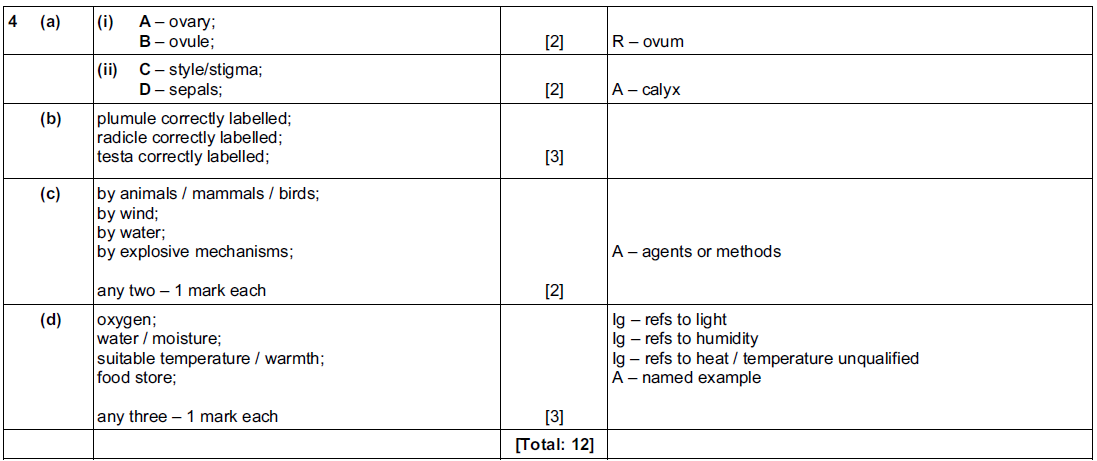
Question
Fig. 5.1 shows a section through a flower
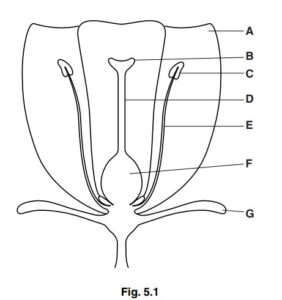
(a) Table 5.1 describes the functions of some parts of the flower.
Complete the table using the label letters from Fig. 5.1.
You may use each letter once, more than once or not at all.
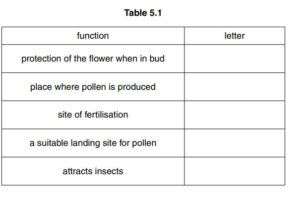
Answer/Explanation
<
Ans:
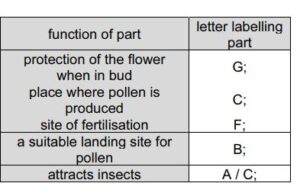
(b) Individual flowers of the same species can be different colours.
Fig. 5.2 is a genetic diagram which shows how colour is inherited for one particular species.
R represents the allele for red flower colour.
r represents the allele for white flower colour.
(i) Complete Fig. 5.2 using words from this list. Each word may be used once, more than
once or not at all.
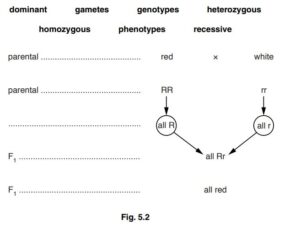
Answer/Explanation
Ans:
phenotype
genotype;
gametes;
genotype
phenotype;
(ii) The F1 red flowers were pollinated with pollen from white flowers.
State the proportion of red to white flowers you would expect in the offspring from this cross.
………………………………………………………………………………………………………………………[1]
[Total: 9]
Answer/Explanation
Ans: 1:1 / equal / 50% : 50% / ½: ½ / 3 : 3 etc.;
Question
Fig. 4.1 shows a seed as it is starting to germinate and the same seed several days later.
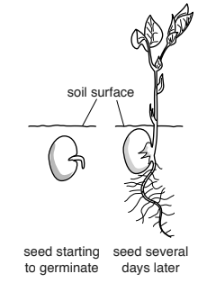
(a) Explain how growth differs from development.
Use information from Fig. 4.1 to help with your explanation.
(b) State three environmental conditions that all seeds need before they can germinate.
Answer/Explanation
Ans:
(a) growth:
1. (seedling) increase in size/(dry) mass /AW ;
2. permanent ( increase in size) ;
3. larger/ more cells ; development:
4. cells become specialised ;
5. increase in complexity ;
6. ref. to formation of new (named) structures ;
(b) oxygen / O2 ;
water / H2O ;
(suitable) temperature / warmth ;
Question
Fig. 6.1 represents an example of a human menstrual cycle.
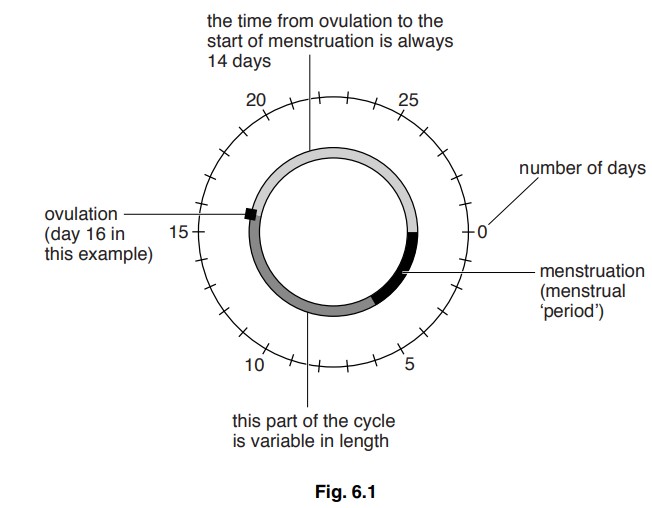
(a) State the part of the menstrual cycle which is always the same length.
…………………………………………………………………………………………………………………………….
(b) (i) A woman’s period started on August 2nd and her next period started on August 29th. Calculate the length of her menstrual cycle for that month.
……………………………………………………………………….. days
(ii) Human sperms can live for up to 48 hours in the female’s reproductive system, and human eggs live for 24 hours after release. Ovulation occurred on 16th August. State the dates in August on which intercourse could result in fertilisation taking place.
…………………………………………………………………………….. August
(c) During menstruation a woman loses blood. This can cause a woman to be anaemic. Symptoms of anaemia are lack of energy, pale colour and tiredness. Explain how these symptoms can be caused by the blood loss during menstruation.
…………………………………………………………………………………………………………………………………
…………………………………………………………………………………………………………………………………
…………………………………………………………………………………………………………………………………
…………………………………………………………………………………………………………………………………
…………………………………………………………………………………………………………………………………
…………………………………………………………………………………………………………………………….
(d) When a woman becomes pregnant a placenta and umbilical cord will form. State the names of three substances which must be able to pass from the woman to the developing fetus across the placenta.
1 ……………………………………………………………………………………………………………………………..
2 ……………………………………………………………………………………………………………………………..
3 ……………………………………………………………………………………………………………………………..
(e) In the plant life cycle seeds and fruits are dispersed.
Fig. 6.2 shows an example of a fruit.
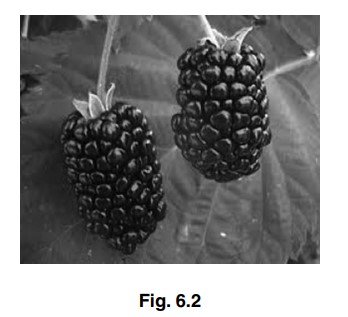
(i) Suggest one way in which this fruit is adapted so that animals are likely to eat it.
………………………………………………………………………………………………………………………….
………………………………………………………………………………………………………………………….
(ii) The animals help to disperse the fruit and seeds. Suggest two advantages of fruit and seed dispersal.
1 ………………………………………………………………………………………………………………………
2 ………………………………………………………………………………………………………………………
Answer/Explanation
Ans:
(a) from ovulation to start of menstruation;
(b) (i) 27 days;
(ii) 14th; (to) 17th;
(c) (loss of blood) means fewer red blood cells;
results in pale colour;
(loss of red blood cells) means less haemoglobin;
(so) less oxygen carried (by blood);
cells cannot carry out sufficient respiration;
causing lack of energy and tiredness;
(d) oxygen;
glucose;
amino acids;
glycerol;
fatty acids;
minerals / iron/ calcium;
vitamins / vitamin C/ vitamin D;
antibodies;
water;
(e) (i) colour;
taste / sweetness;
succulence/AW;
smell;
(ii) prevents overcrowding/ less competition;
for minerals /water;
for light;
new habitat/ colonisation;
(existing) variations may be advantageous in new habitat;
